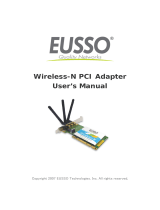
CONTENTS
Chapter 1 Product Overview ................................................................................. 1
1.1 Package Contents................................................................................................... 1
1.2 Introduction ............................................................................................................. 1
1.3 Features.................................................................................................................. 2
1.4 Hardware Overview................................................................................................. 2
Chapter 2 Installation............................................................................................. 3
2.1 Hardware Installation .............................................................................................. 3
2.2 Software Installation................................................................................................ 3
Chapter 3 Connect to a Wireless Network ........................................................... 8
3.1 To connect using TWCU ......................................................................................... 8
3.2 To connect using WPS.......................................................................................... 11
3.2.1 PBC (Push Button Configuration) method................................................ 11
3.2.2 PIN method .............................................................................................. 13
3.3 To connect using Windows built-in wireless utility................................................. 15
3.3.1 In Windows 7............................................................................................ 15
3.3.2 In Windows Vista...................................................................................... 17
3.3.3 In Windows XP......................................................................................... 19
Chapter 4 Management........................................................................................ 22
4.1 Profile.................................................................................................................... 22
4.1.1 Add a profile ............................................................................................. 22
4.1.2 Modify a profile......................................................................................... 24
4.1.3 Delete a profile ......................................................................................... 24
4.2 Advanced .............................................................................................................. 25
4.3 About..................................................................................................................... 26
Chapter 5 AP Mode .............................................................................................. 27
Chapter 6 Uninstall Software............................................................................... 29
6.1 Uninstall the utility software from your PC............................................................. 29
6.2 Uninstall the driver software from your PC............................................................ 30
Appendix A: Specifications................................................................................... 31
Appendix B: Glossary............................................................................................ 32






















